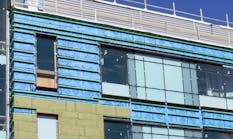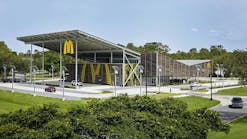Designed by Hariri Pontarinin Architects, the 7 St. Thomas commercial development, in Toronto, restored and repurposed a row of six 1880s red brick townhouses into a new three-story podium that hosts a six-story curved glass tower with a gradient frit.
The contrast between the solidity of the red brick heritage houses below with the translucent permeability of the glass tower—which steps back and appears to float above the Victorian frontages—highlights both typologies, according to the architect.
To maximize daylight and views, Hariri Pontarinin selected the SunGuard SuperNeutral 68 coating on low-iron bent and flat glass.
“The glass helps to illuminate interiors, expand views and connect indoors and out. This product was identified by the glass team as the best product to maintain its high performance with the complexity of the cylindrical bends and the frit pattern,” explains Emerich.
The low-iron substrate also reduces the green tint often seen with standard float glass.
The curved white glass curtain wall affords unobstructed views for the upper levels. Ceramic frit minimizes solar heat gain while the glass is designed to retain heat in winter, lowering cooling and heating costs.
- Hariri Pontarini Architects
Fabrication Challenges
The wave design and frit pattern introduced complexities into the glass fabrication process. Consequently, the fabricators BVGlazing, Trulite Glass and Aluminum Solutions, and Standard Bent Glass had to navigate a number of restrictions:
- High performance, low-e coatings could only be fabricated on the concave surface of bent glass.
- Ceramic frit patterns could only be coated on the concave surface of bent glass.
- The building elevation features units viewed from both convex and concave. To best feature the white decorative frit, the glass lite with the frit had to be in front of the lite with the low-e coating, and as close as possible to the first surface.
Solutions
To achieve the desired look and performance for the convex view, the white gradient frit was placed on the No. 2 concaved surface, while the SunGuard SuperNeutral 68 coating was placed on low-iron glass on the No. 4 concave surface. For the concave view, the white gradient frit is on the Nov. 4 concave surface with the glazing on the No. 5 concave surface.
For this project, Standard Bent Glass used direct–to-glass printing and BVGlazing created unitized systems to simplify installation in a congested job site.
“Guardian Glass was pleased to be part of a project that puts on display the possibilities of bending high performance low-e glass. The stunning results speak for themselves,” says Emerich.


